Can a Drone Lift a Person? Explained
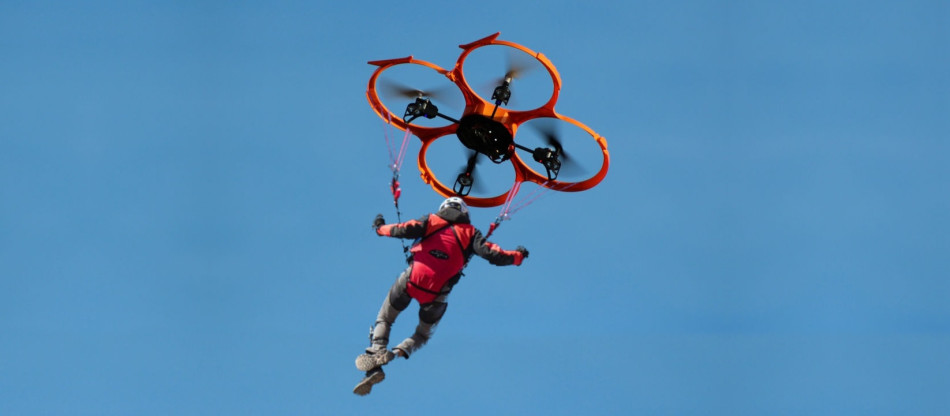
Drones, also called unmanned aerial vehicles (UAVs), have become increasingly popular in recent years. They can be used for many things, like taking pictures from above, delivering packages, and for rescue missions. One question that comes up often is whether or not a drone can lift a person. In this article, we’ll talk about that. So, let’s start!
So, Can A Drone Lift A Person? Yes, some drones are able to lift and transport a person. These drones are known as “heavy-lifting drones”. Things that depend on whether a drone can lift and carry a person are the propeller type, the engine’s power, and the weight of the person that the drone needs to lift.
When we talk about heavy-lifting drones (UAVs) that are usually used in the military, the most common feature that they have is to carry extra weight while flying. Manufacturers have already created drones for various uses, as seen today.
Now we can witness a drone lift a person and fly it around, much like what we saw in Battle Drones. The first such recorded occurrence happened at CES 2016 in Las Vegas. Ehang 184 was the first drone to complete this.
How Much Can a Drone Lift?
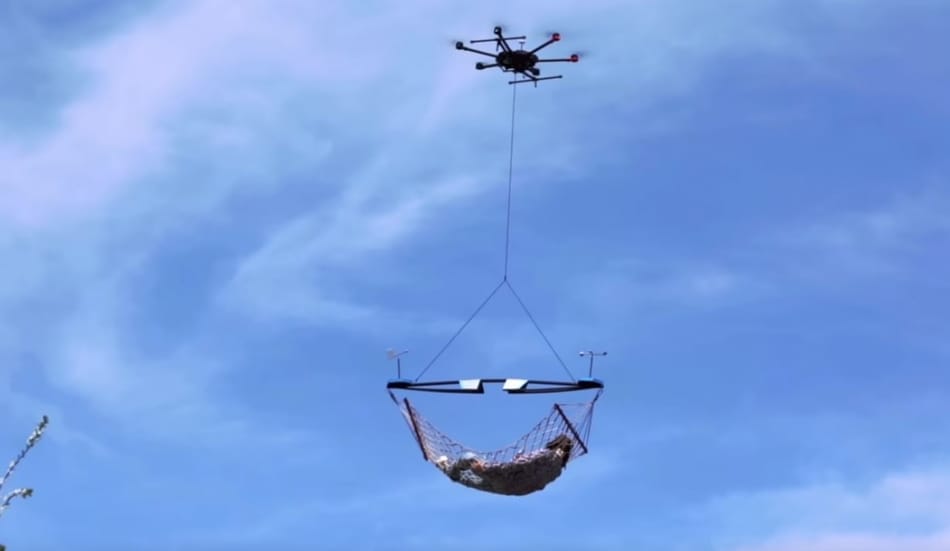
The weight a drone can lift depends on several factors, including the size and design of the drone, the power of its motors, and the efficiency of its propellers. Small consumer drones, such as those used for aerial photography or racing, typically have a maximum lift capacity of a few pounds.
On the other hand, larger industrial drones, such as those used in construction or search and rescue operations, can lift between 44 to 485 lbs. For example, some heavy-lift drones can lift payloads weighing up to several hundred pounds.
It’s important to note that the weight a drone can lift is also affected by the altitude and wind conditions in which it operates, as well as the drone’s flight time and battery life.
The Physics Of Heavy-Lifting Drones
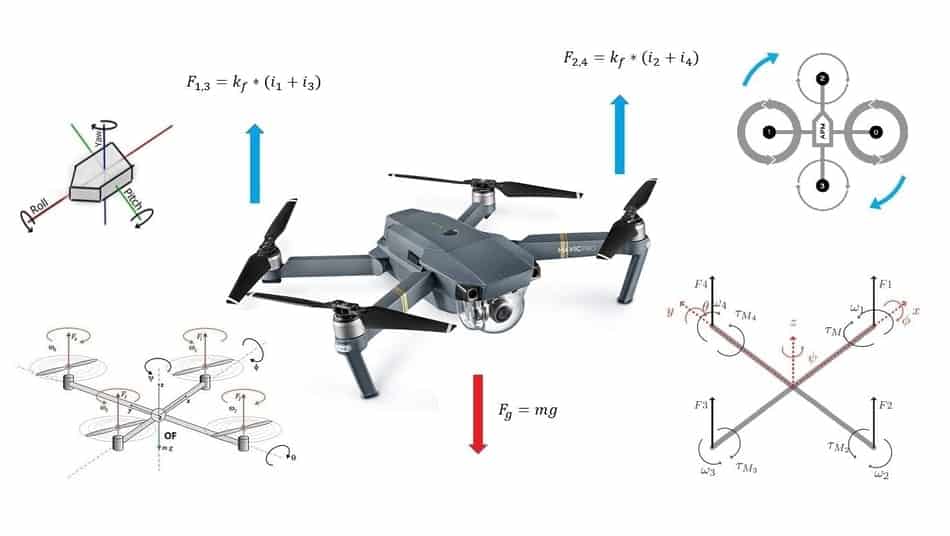
The physics of heavy-lifting drones lies in a complex combination of aerodynamics, propulsion, and structural engineering. If you want to learn more about this topic, read: Physics Behind How Drones Fly.
For a drone to lift a heavy payload, it must generate enough lift to overcome the weight of the payload and the drone itself. This is achieved through powerful motors that drive large propellers, which generate thrust to lift the drone off the ground.
The design of the drone’s body and wings also plays a crucial role in its ability to lift heavy loads. A heavy-lifting drone must have a strong and durable structure that can withstand the forces generated during flight, and it must be aerodynamically efficient to minimize drag and maximize lift.
Additionally, the drone must be equipped with advanced control systems to maintain stability and navigate while carrying a heavy payload.
3 Drones That Are Capable To Lift a Person
Here are three models that can easily lift and carry a person from one place to another.
Ehang 184
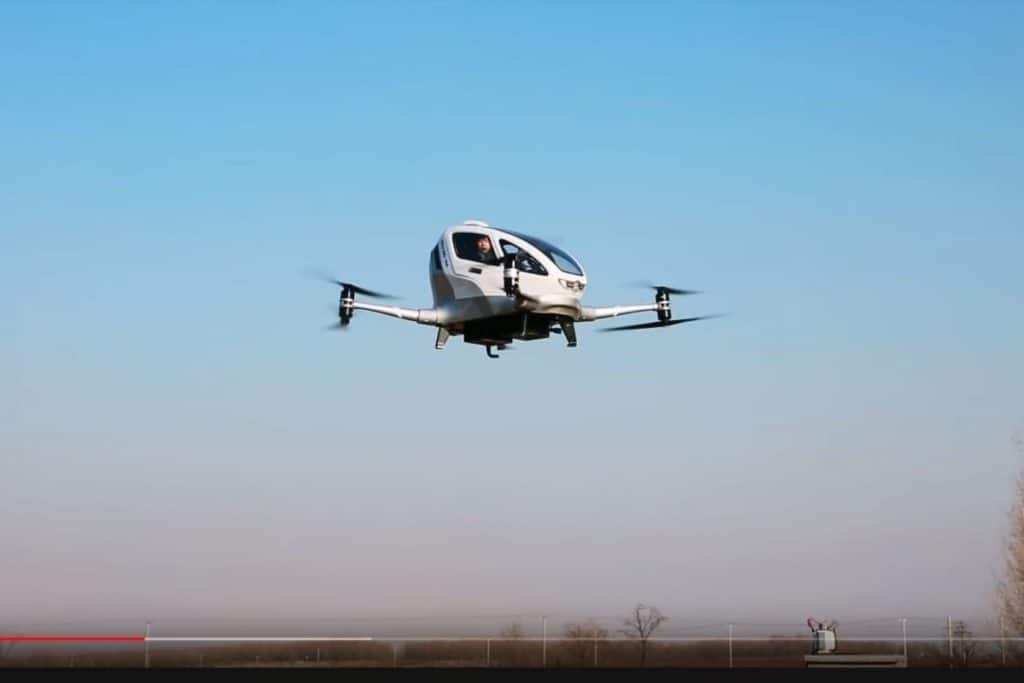
The EHang 184 is a passenger-carrying drone developed by the Chinese company EHang. It is a fully autonomous drone that can carry one person and a small amount of luggage at a speed of up to 60 mph and a maximum altitude of 11,000 feet. The drone is powered by eight rotors and has a range of about 31 miles on a single charge.
The EHang 184 is designed for urban air mobility to provide efficient and convenient transportation for short distances. The drone can be controlled through a smartphone app, and a command center monitors its flight to ensure safety. The EHang 184 has done several successful test flights. However, it is not yet available for commercial use as it is still in the testing and certification phase.
Related Article: Can Drones Take Your Temperature?
VoloDrone
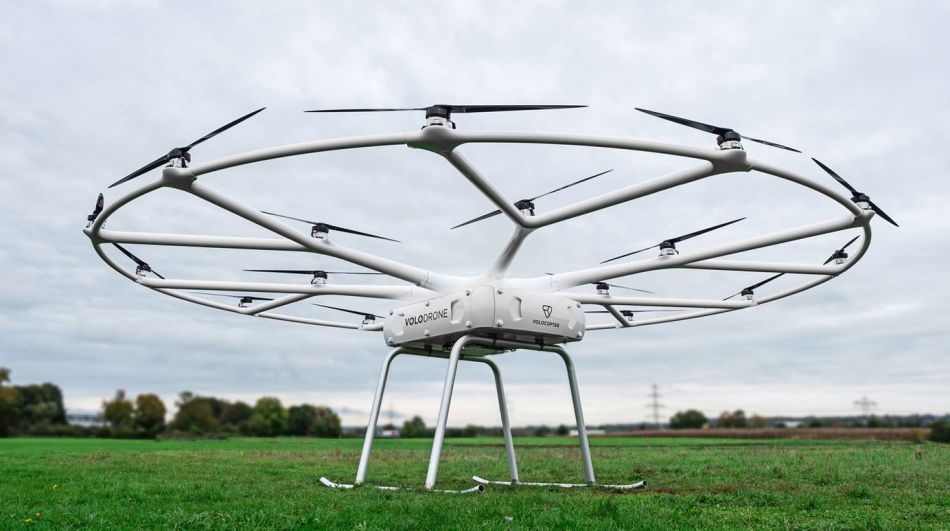
VoloDrone is a heavy-lift drone developed by Volocopter, a German company specializing in electric vertical take-off and landing (eVTOL) aircraft. The VoloDrone can lift payloads up to 440 lbs and has a flight time of up to 30 minutes. It features a modular design that allows it to be configured for various applications, including cargo delivery, construction, and inspection.
It’s powered by 18 rotors, which allows it to take off and land vertically, and it can reach a top speed of 68 mph. The VoloDrone also features advanced navigation and control systems, including GPS and obstacle avoidance sensors, allowing it to perform autonomous missions.
VoloDrone is intended for civil and industrial use, such as heavy cargo transportation, wind turbine maintenance, and other industrial applications. It is not yet commercially available as it is still under development.
Griff 300
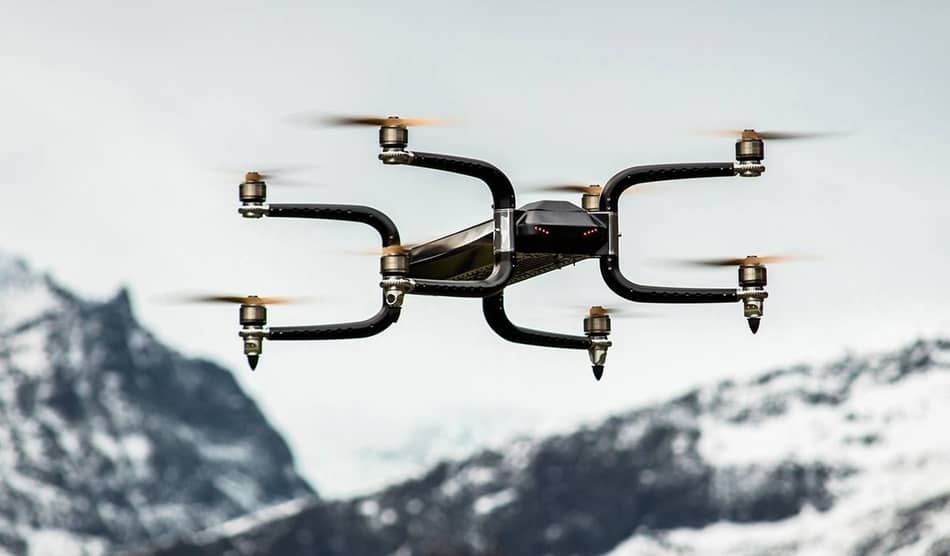
The Griff 300 is a heavy-lift drone developed by Griff Aviation, a Norwegian company specializing in unmanned aerial systems. It is a hexacopter drone capable of lifting payloads weighing up to 225 kg (496 lbs) and has a flight time of up to 45 minutes.
The drone is powered by six electric motors and has a maximum speed of 40km/h. The Griff 300 is designed for industrial and commercial use, such as construction, agriculture, and emergency services.
It has a large payload capacity and can carry a variety of tools and equipment, including cameras, sensors, and sprayers. It also features advanced navigation and control systems, including GPS and obstacle avoidance sensors, allowing it to perform autonomous missions.
Griff 300 is designed for the civil applications, like lifting cargo and providing heavy lift capability for various industries, and it is available for purchase.
Drone Lifting a Human While Snowboarding
YouTuber Casey Neistat filmed an adrenaline video utilizing a custom-made drone that could lift and fly around a snowboarder. The drone was created and modified specifically for the movie Neistat shot over the course of a year after he couldn’t locate any commercially available drones to complete this project.
The large 16-rotor machine in this huge drone gives it the weight it needs to transport people. We can see one-man drones capable of transporting people from A to B in Neistat’s attempt, which was previously impossible.
He called out that this video was sponsored by Samsung in this example. The Gear 360 camera from Samsung was utilized, as well as for some another few shots.
Here you can see the full video:
What Happens When Drone Loses its Payload During a Flight?
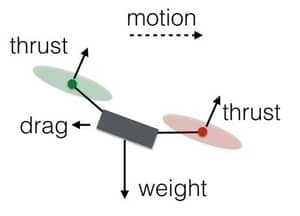
When a drone loses its payload during a flight, it can result in several different outcomes depending on the specific circumstances of the incident. If the payload is released during the flight, the drone might lose its balance and crash.
If the drone is being flown in a controlled environment, such as a warehouse or construction site, the operator will likely have procedures in place to safely land the drone and secure the payload. In the case of outdoor flight, the operator will likely have a plan in place to locate and retrieve the payload.
If the drone is being flown in a public area, the operator will likely need to locate and retrieve the payload. If the payload is not retrieved, it can cause damage or injury to people or property on the ground.
Drone operators need to have safety procedures in place to prevent payload loss and to take appropriate action if it does occur.
In any case, it’s important to note that an incident like this can also cause damage to the drone itself and can cause it to malfunction and crash, therefore, it’s crucial for the operator to follow safety procedures to prevent such an incident from happening.
FAQ: People Also Aks
How much weight can a drone lift?
Many of the drones that have become quite popular among filmmakers and pilots who are filming footage and out for fun can carry up to 2-4 pounds as a payload. When you’re talking about weights that are more than 10 pounds, you’re generally looking at something hefty.
Can a drone lift 200 lbs?
The Dauntless UAV, which is manufactured in Kentucky, is a new development that can carry and lift up to 200 pounds (90 kg). The Dauntless is offered as either a quadcopter or an octocopter, depending on whether you add extra motors and rotors to each of its four arms.
Final Thoughts
After we’ve gone through everything, it’s clear that technology is progressing at the speed of light, and so the world of drones. Today on the market, we have a few drones that are designed to lift and transport a Human, and they’re known as “Professional Drones”. Drones are designed to fulfill a specific function: they’re used to transport extra weight while in flight. When considering when drones will be carrying passengers from Point A to B, the only question is how fast technology will develop.
However, for the time being, it will take many years for you and I to purchase and fly a drone like this. For the time being, we must be content with our current modes of transport, such as cars, buses, and metro systems, to get from A to B. I’d love to hear your thoughts on the subject in the remarks area below.

